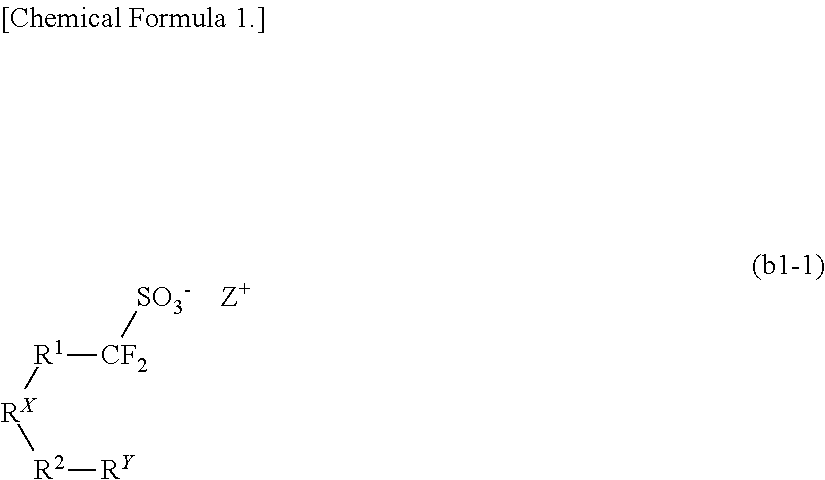Resist composition, method of forming resist pattern, novel compound, and acid generator
a composition and resist pattern technology, applied in the field of resist composition, can solve the problems of unsatisfactory mask reproducibility, roughness, and unsatisfactory exposure latitude of resist pattern, and achieve excellent lithography properties such as mask reproducibility and exposure latitude, and reduce roughness
- Summary
- Abstract
- Description
- Claims
- Application Information
AI Technical Summary
Benefits of technology
Problems solved by technology
Method used
Image
Examples
example 1
Synthesis of Compound (B1-1-1)
[0614]i) Synthesis of Compound (2)
[0615]In a nitrogen atmosphere, 5.00 g of a compound (1) and 5.61 g of HIMIC anhydride were dissolved in methylene chloride and cooled to 10° C. or lower. Then, 3.53 g of 4-dimethylaminopyridine was dropwise added to the methylene chloride solution. After maturing for 3 hours, the resultant was filtered, and pure water was added to the obtained filtrate to conduct extraction with water. 31.67 g of a 5 wt % aqueous hydrochloric acid solution was added to the obtained aqueous solution, followed by filtration. The residue was collected, and subjected to disperse washing with pure water, thereby obtaining 5.12 g of a compound (2) in the form of a white solid.
[0616]The obtained compound (2) was analyzed by 1H-NMR, and the structure thereof was identified by the following results.
[0617]1H-NMR (400 MHz, DMSO-d6): δ(ppm)=6.23 (m, 1H, A), 6.06 (m, 1H, A′), 4.78 (m, 1H, N1), 4.43 (m, 1H, N2), 3.81 (m, 1H, N3), 3.42-3.21 (m, 3H, B...
example 2
Synthesis of Compound (B1-1-2)
[0652]i) Synthesis of Compound (10)
[0653]The same procedure as in i) of Example 1 was performed, except that a compound (9) was used instead of the compound (1), thereby obtaining a compound (10) in the form of a white solid.
[0654]The obtained compound (10) was analyzed by 1H-NMR, and the structure thereof was identified by the following results.
[0655]1H-NMR (400 MHz, DMSO-d6): δ(ppm)=6.22 (m, 1H, A), 6.06 (m, 1H, A′), 5.41 (m, 1H, O1), 4.66 (m, 3H, O2-4), 3.33-3.22 (m, 2H, B), 3.08-3.01 (m, 2H, C), 2.72 (m, 1H, O5), 2.11-2.04 (m, 2H, O6-7), 1.31-1.28 (m, 2H, D)
[0656]ii) Synthesis of Compound (11)
[0657]The same procedure as in ii) of Example 1 was performed, except that a compound (10) was used instead of the compound (2), thereby obtaining a compound (11) in the form of a white solid.
[0658]The obtained compound (11) was analyzed by 1H-NMR and 19F-NMR, and the structure thereof was identified by the following results.
[0659]1H-NMR (400 MHz, DMSO-d6): δ(p...
example 3
Synthesis of Compound (B1-1-3)
[0666]i) Synthesis of Compound (12)
[0667]The same procedure as in i) of Example 1 was performed, except that exo-3,6-epoxy-1,2,3,5-tetrahydrophthalic acid anhydride was used instead of HIMIC anhydride, thereby obtaining a compound (12) in the form of a white solid.
[0668]The obtained compound (12) was analyzed by 1H-NMR, and the structure thereof was identified by the following results.
[0669]1H-NMR (400 MHz, DMSO-d6): δ(ppm)=6.44 (m, 2H, A), 5.12-5.06 (m, 2H, B), 4.74 (m, 1H, N1), 4.47 (m, 1H, N2), 3.86 (m, 1H, N3), 3.42 (m, 1H, N4), 2.73 (m, 2H, C), 2.42 (m, 1H, N5), 2.14 (m, 1H, N6), 1.87-1.74 (m, 3H, N7-9)
[0670]ii) Synthesis of Compound (13)
[0671]The same procedure as in ii) of Example 1 was performed, except that a compound (12) was used instead of the compound (2), thereby obtaining a compound (13) in the form of a white solid.
[0672]The obtained compound (13) was analyzed by 1H-NMR and 19F-NMR, and the structure thereof was identified by the followi...
PUM
| Property | Measurement | Unit |
|---|---|---|
| temperature | aaaaa | aaaaa |
| boiling point | aaaaa | aaaaa |
| boiling point | aaaaa | aaaaa |
Abstract
Description
Claims
Application Information
 Login to View More
Login to View More - R&D
- Intellectual Property
- Life Sciences
- Materials
- Tech Scout
- Unparalleled Data Quality
- Higher Quality Content
- 60% Fewer Hallucinations
Browse by: Latest US Patents, China's latest patents, Technical Efficacy Thesaurus, Application Domain, Technology Topic, Popular Technical Reports.
© 2025 PatSnap. All rights reserved.Legal|Privacy policy|Modern Slavery Act Transparency Statement|Sitemap|About US| Contact US: help@patsnap.com



